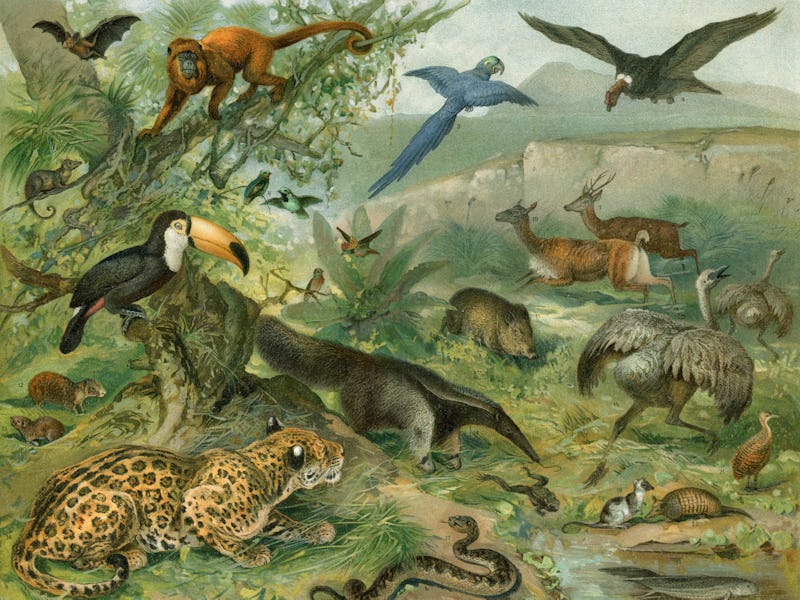How mapping soundscapes could revolutionize forest conservation
New tech is set to help scientists "collect a different dimension of forest quality."

Getting robust information about forest health is key to conservation — it can tell researchers if a forest is healthy, struggling, or plagued by illegal logging.
But conducting long-term observations over huge areas of land presents a logistical conundrum. Humans can trek the forest to gather data, but you can only station a person out in the forest for so long.
To get around those issues, researchers are turning their focus to the sounds of the forest and innovative technology that allows them to capture those sounds in unprecedented detail.
Investigations led by Sarab Sethi, a postgraduate researcher at Imperial College London, are fueled by a massive audio dataset that allows for the analysis of forest soundscapes. Sethi's goal is to use sound to automate the process of ecological monitoring, by setting up recording devices in forests around the world.
Being able to set a device and walk away is a workaround for some of the logistical issues that challenge ecologists, Sethi tells Inverse. The new technology could be part of a recent push for better tools that complement each other and help conservationists and land-owning companies track the health of forests, experts say.
In a study published on July 7 in the Proceedings of the National Academy of Sciences, Sethi and his colleagues describe how they used machine learning to create this forest monitoring tool. Training the technology to perceive what a normal, healthy forest sounds like helps detect anomalies. In turn, that can benefit conservationists who track long-term ecosystem shifts.
It can also signal when illegal human activity is underway by detecting the sound of chainsaws in a protected area, for example.
In the past, forest audio research has been more narrowly focused, Sethi says — used to zero in on a particular bird species, for instance, to determine if a population is healthy. But that work involves sifting through data to pull out specific information and tends to be specific to one region.
Instead, Sethi is recording audio of forests in their entirety, which allows him to look at ecosystems holistically. The method can be used anywhere, he says.
"What we did in Borneo we also did in a temperate forest in Ithaca," Sethi says. "We didn't need to tweak our methods."
Rhinoceros Hornbill in a tree in Borneo, a biodiversity hot spot.
Long-term listening — Sethi's team plans to launch the new tool within the next year or so, as part of the World Wildlife Fund's Stability of Altered Forest Ecosystems (SAFE) Project. On the project's website, you can livestream audio clips from tropical rainforests around the world.
Sethi says the tool could be handy in national parks or other protected areas to help detect unusual activity. In the future, park rangers could get a weekly update, for instance, with a list of the most anomalous sounds. That would allow them to further investigate and act accordingly.
Jennifer Lucey, a tropical biodiversity ecologist at Oxford University, tells Inverse that using audio technology can be especially helpful over the long-term.
Because the listening devices could be set and left in place, it would be possible to get weeks or entire seasons of data without relying on a human in the field.
"You can get information across a 24 hour period — in the middle of the night as well as the middle of the day — which you can't do with a human usually," says Lucey, who wasn't involved in the study but has consulted with Sethi about the implementation of the new technology.
Adding audio to other types of forest data, like on-the-ground observations, allows researchers to "collect a different dimension of forest quality," Lucey says.
Orangutans only live on the islands of Borneo and Sumatra.
Complementary conservation tools — Evolving technology can change the scope of conservation efforts, Lucey says, at a time when more private companies are looking at how they manage land.
Lucey works with the oil palm industry to encourage more sustainable practices. She says that there's been a recent awakening that conservation "can't just happen in national parks" and other government-run nature preserves.
There's also a new push for technology to help do the work, Lucey says. Audio monitoring, she argues, is poised to become a part of a growing suite of conservation technologies.
Currently, Lucey is working on a survey-based smartphone app that lets users answer questions about forest health, effectively crowd-sourcing biodiversity assessment. Meanwhile, satellite data and laser scans give researchers a view from above to identify forest patterns.
"I think there's a real call for really easy-to-use, effective, scientifically robust monitoring tools," Lucey says.
But satellites can't capture issues like poaching, which occurs beneath the tree canopy, and collecting audio from noisy places — like next to a gushing river — may not be the most successful method of study.
"It's picking the right tool for the right situation," Lucey says. "What will be really good is if they can interact, integrate, and complement each other."
This article was originally published on